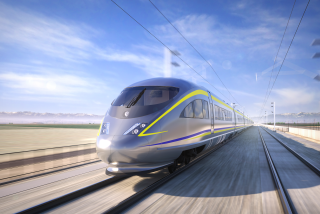High-speed rail ... or fail?
When it comes to California’s plans for high-speed rail, scads of people have strong opinions. But that shouldn’t be a surprise.
As I noted in Wednesday’s column, voters in 2008 approved a 520-mile train route that was supposed to cost $33 billion and be completed in 2020. Since then, not 10 feet of track have been laid, the estimated cost has tripled and the completion date is now 2033.
And those are just guesstimates.
Readers by the hundreds weighed in after that column. Many of them were still passionate about moving ahead, while others insisted it’s time to give up the dream. And quite a few couldn’t believe Gov. Jerry Brown is still pushing the project despite the state’s staggering financial burdens.
When you can’t figure out how to pay for schools and colleges, road improvements, support for the elderly and disabled — not to mention a hundred other things — should you begin building a railroad no one is sure how to pay for? Especially when several recent reports, including one by the railroad authority’s own peer review group, suggest there’s a huge risk of financial disaster?
Those seemed like fair questions to put to Dan Richard, who served on the Bay Area Rapid Transit board for 12 years and has been picked by Brown to save high-speed rail. My first question, when we spoke Thursday, was one that lots of readers asked.
What went wrong between 2008 and now?
Two things, Richard said. First, it became increasingly clear that the completion date had been too optimistic. Second, revisions on the precise route and station locations added more time, inflation and expense.
“It’s not a great answer,” he admitted.
Richard wasn’t involved in the beginning, but said he recently met an early critic who had warned that the system would cost closer to $90 billion than $33 billion. Richard complimented him on his prescience.
So how can Richard win back onetime supporters who feel like they’ve been swindled?
“The first thing you do is tell the truth,” he said about costs and everything else. The current estimated cost of $98 billion, he said, is based on $65 billion in 2010 dollars, plus inflation.
But his orders from Brown, he said, were to find out whether there’s a way to build the line cheaper, faster and better.
Well, is there?
Richard thinks so, but he’s still working on convincing himself and others. A lot of people have lost faith, he knows. So his task is to prove there’s “value in this” for ourselves, our children and our grandchildren.
OK, but where would he get the money? Voters approved less than $10 billion in startup funds in 2008, and Richard said he won’t go back to them with another bond. So that means years of begging in Sacramento and Washington, both of which are underwater.
Richard said the railroad authority has to build a better model and convince lawmakers it’s a wise investment, and a big piece of that is finding ways to lure private investment. He hopes to draw $11 billion to $20 billion of the construction cost from private sources and then essentially have private companies run the railroad once it’s completed.
Why would investors be interested?
Because in other parts of the world, Richard said, high-speed systems have operating profits, not counting the initial investment.
“If California is going to have 20 million more people in the next 20 or 30 years,” said Richard — a projection that is speculative — “how do they move around? One choice is, we don’t make the investment. We say the heck with it and suffer the congestion and we suffer more air pollution.”
Those who question public investment in a railroad have to remember that there are public subsidies for airports and highways, too, Richard said.
“We think this is much cheaper than alternatives.”
But that’s hard to prove. I told Richard I’d heard from lots of readers who worried that we might be investing in a railroad whose technology is outdated, if not obsolete, when it’s finally finished. High-speed, computer-programmed driverless cars are no longer the stuff of science fiction. And then there are cheerleaders for high-speed Maglev trains, a magnetic levitation system that’s already in use in Shanghai, among other places.
“I’m not going to say there’s not a risk,” Richard conceded, “but from everything I’ve heard, there’s not a significant risk” that such technologies will be widely available or preferable.
But will enough drivers get out of their cars in 2033, or give up on air travel? Will millions of people who don’t live near a high-speed station, and can’t easily get to one because of heavy traffic and inadequate regional transit, ever ride the bullet?
We don’t know what jet fuel will cost, or how long airport security check-in will take in 2033. High-speed rail folks say the projected cost of a train ticket from Los Angeles to San Francisco — a trip of 2 hours and 40 minutes — will be 83% of the cost of a plane ticket. But like everything else, that’s speculative.
At its best, Richard argued, high-speed rail can create jobs, offer travelers and commuters another option and become a national model.
“I am a guy who believes society has to invest in people and physical infrastructure … and high-speed rail is very high-tech and could spawn a support industry,” Richard said.
His idea of stepping back first, to figure out whether it all makes sense, is the right move for now.
Some of us who want to be believers need a lot more convincing.
More to Read
Sign up for Essential California
The most important California stories and recommendations in your inbox every morning.
You may occasionally receive promotional content from the Los Angeles Times.











